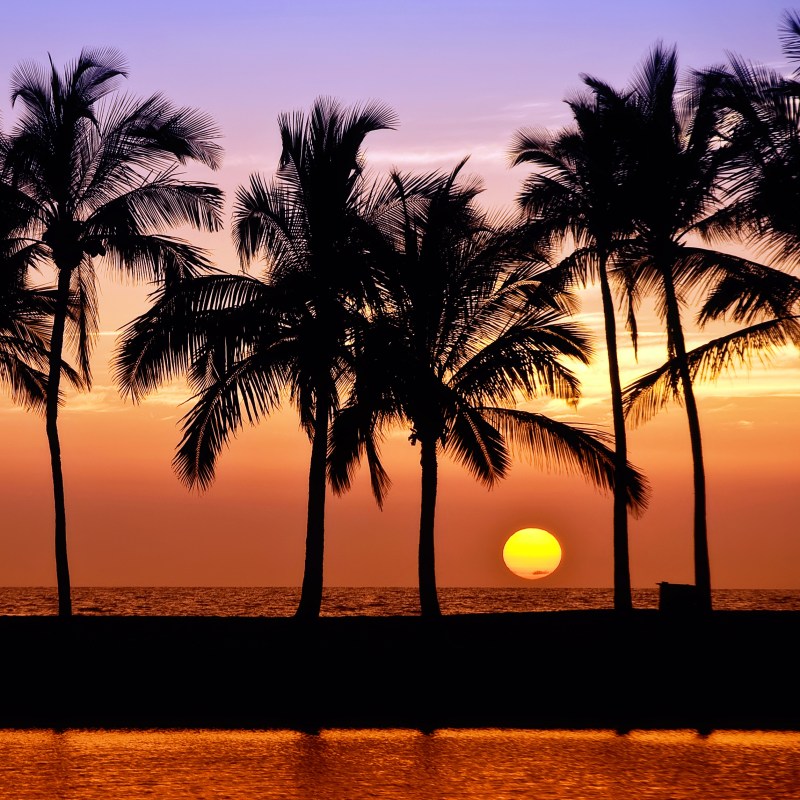
The Island of Hawaii, the biggest island in the chain that makes up our nation’s 50th state, is a topographical wonder. Visitors can stroll green sand beaches, climb black volcanic boulders, view active lava flows, lose themselves in lush tropical forests, and explore the sacred mountain ranges where ancient Hawaiians believed the islands first emerged.
Videos by TravelAwaits
It’s also possible to sample many of these wonders in a single day.
We did it on a whim. Since we opted for a rental car, we decided to spend 14 hours of our vacation time driving all the way around the island. While you absolutely should spend more than a day here, this was a fun, fast-paced way to take in much of Hawaii — aka the Big Island’s — splendor in a single mad dash. It’s one of our favorite travel experiences. Here’s how you can do it, too.

Rise Early And Sip Kona Coffee
We stayed at the historic Mauna Kea Beach Hotel, a mid-century marvel located outside the town of Waimea, on the gorgeous Kohala Coast. We packed up early and headed south on Highway 19, along the black volcanic landscape toward Kailua-Kona. It took about an hour to reach the town, famous for its rich, fabulous coffee and annual IronMan competitions.
Once there, we parked our car, strolled the beachfront, and checked out the historic Mokuaikaua Church before stopping into Daylight Mind Coffee Company for the best pour-overs we’ve ever had (with locally grown beans, of course!). After our quick nosh, we hopped back into the car, got on Highway 11 South, and continued our adventure.
Grab Roadside Snacks
All along our trip, we spied roadside stands offering tropical fruits and nuts for sale. We drove through gorgeous, vast coffee and macadamia plantations springing from the rich volcanic soil. Small shops dotting the coastal highways sold juices, coffee beans, and both fresh and dried fruits.
Stop at any one of these for a quick local snack! You won’t be disappointed.
See Captain Cook’s Last Stand
About 20 minutes down the road from Kailua-Kona, we neared the tiny town of Captain Cook. Reaching its namesake — Captain James Cook’s — waterside monument is a one-hour hike through Kealakekua Bay State Historical Park. Instead of committing to the hike, we opted to look out across Kealakekua Bay and consider the history of this spot.
Cook, thought to be the first Westerner to reach the Hawaiian Islands in 1778, was first greeted as a god by the Native Hawaiians. He and his crew outstayed and exploited their welcome, and Cook was killed after a series of skirmishes turned violent in 1779. The spot where Cook died is now marked by a white obelisk. In a symbolic move, the Kingdom of Hawaii gifted a small parcel of land around the memorial to the British in 1877.

Sightsee And Snorkel Pu’uhonua O Honaunau
A quick jog to the south landed us at Pu’uhonua O Honaunau National Historical Park. Called the City of Refuge by those who sought mercy here from the death penalty, this beach is the spot where the chiefs of the Big Island ruled. The original temple was constructed in honor of King Kamehaema’s grandfather, and the bones of the royals were entombed here for generations. A replica now stands on the site, and U.S. park rangers give tours daily.
Looking out onto the vast sea dotted with schools of tropical, colorful fish, you can instantly recognize why Native Hawaiians still consider this gorgeous outcropping a sacred site. Treat it with respect: No beach supplies, pets, picnics, or recreational activities like frisbee or football are allowed.
Also note that there is a $15/car fee to enter the park.
A short walk away, you’ll find some of the best snorkeling in the islands. The so-called Two Step Honaunau Bay entry point is nicknamed for the two lava outcroppings you’ll use to enter the water since there’s no beach. Ease yourself in, and prepare to be amazed.
We spotted tangs, turtles, and coral reef canyons during our snorkel. This beauty doesn’t come without some dangers: The surf can be choppy, you’ll need to watch for sea urchins, and the lava is so sharp it can cut. (Consider a pair of water socks!) Luckily, if the conditions are right, you’ll view an underwater world that looks like something from Finding Nemo. We spent about an hour at each site.
Visit Mark Twain’s Monkeypod Tree
After we’d dried off and stowed our snorkel gear, we continued south on Highway 11. Near the city park in Waiohinu, we spied a bit of folklore centering around one of America’s most beloved writers.
In 1866, Mark Twain visited the Big Island and wrote home about the lush flora and trees he saw. Legend has it he planted a monkeypod tree before leaving the area to mark his visit. While the original tree was blown away by a hurricane in the 1950s, a sign marks the spot where another sprouted up from its roots. It still stands today, majestically hanging over the highway.
After the jam-packed morning, we were ravenous. Just outside of Waiohinu, we stopped for a late lunch at the Hana Hou Restaurant, which claims to be the southernmost restaurant in the United States. We noshed on katsu chicken, sandwiches, the ubiquitous Hawaiian macaroni salad, and a slice of their renowned coconut cream pie before continuing on Highway 11. We’d reached the tip of the island, and were now headed north.

See Black Sand And Sea Turtles
After our big and much-needed lunch at Hana Hou, we drove about six miles north to yet another beach. Punalu‘u is famed for its black sand and resident turtles, and we decided it was a must see. This palm-lined stretch of dark sand was a short jog off Highway 11 with ample parking.
We popped out to take a 20-minute stroll and while we were there, we spied three of the sea turtles that make the beach their home. While their area is roped off in an effort to keep curious people at bay, it bears repeating: Keep a safe distance from these magnificent creatures.

Discover Pele’s Home
Another half hour to the north, we reached our second national park of the day: Hawaii Volcanoes National Park. This remarkable place stretches more than 500 square miles and is where the earth literally renews and recreates itself as lava turns to stone. It’s also thought to be the home of the Hawaiian goddess Pele. She was especially active in 2018, when Kilauea erupted.
It’s important to note that the park has changed significantly since the eruption, and that we visited prior to the event. You’ll want to check the park’s website for information on what’s currently open as the park comes back online.
We paid the $25 entrance fee at the front gate and took the Crater Rim Drive. Our first stop was at the steam vents, spots where groundwater seeps down to the hot volcanic rock underneath and resurfaces as steam. From there, we gawked at several overlooks that gave us glimpses of Kilauea and saw families of nene, endangered Hawaiian geese. We also walked through several lava tubes.
At the time of our visit, we were able to tour the Jaggar Museum and glimpsed the lava glow from there as the sun went down. Unfortunately, it’s unclear if the museum will ever reopen due to structural damage sustained during the eruption and earthquakes.
One more thing to note: Smog from volcanic activity (called VOG) can be rough. Consider bringing a mask as a precaution if you have asthma or another respiratory issue.
We spent two and a half hours taking in the sights of this magnificent park.

Savor Burgers And Brews
By the time we left the park, night had fallen, and we were ready to eat again! We headed due north on Highway 11 for 45 minutes to reach the Big Island’s largest city, Hilo. Situated on the east side of the island, Hilo has a tropical climate, with 130 inches of rain on average each year. It’s surrounded by lush forests and waterfalls, and is known for its many museums and festivals.
Once we got to town, we immediately made our way to Hilo Burger Joint. This cozy spot is exactly what you’d picture: a small, friendly pub with local beers on tap and locally-raised beef burgers. We were lucky enough to be there during Trivia Night. Of course, we played along and managed not to embarrass ourselves too badly!
From there, it was time to head home. We were exhausted after our trek around the Big Island, and we still had another hour to get back to Waimea. But we crammed our one-day road-trip with amazing sites and now have the memories to last a lifetime.

Keep In Mind
If you decide to make a similar trek, make sure you pack plenty of snacks, sunscreen, and water, and be sure to stop for gas in Kona and Hilo. Some of the small towns you’ll pass through are outposts with limited services. Also wear decent hiking shoes so you can make the most of your stops along the way.
We spent a total of five days on the Big Island; this marathon day merely skimmed the surface of what the island has to offer (see a map of our route above). That said, it was an absolute blast to circumnavigate this amazing place between sunup and sundown. Aloha!
